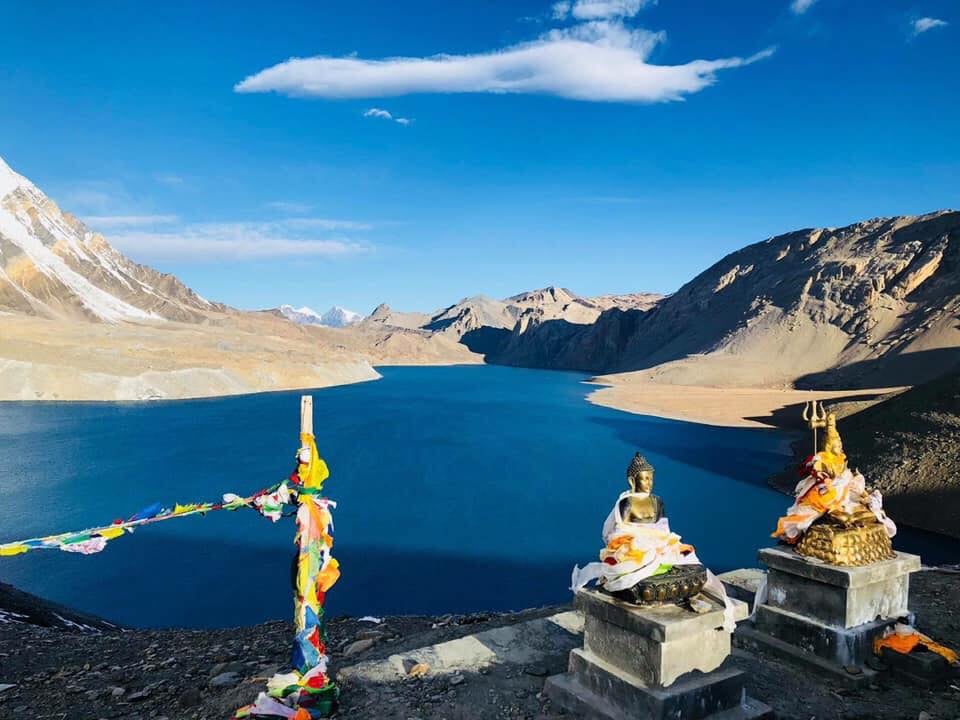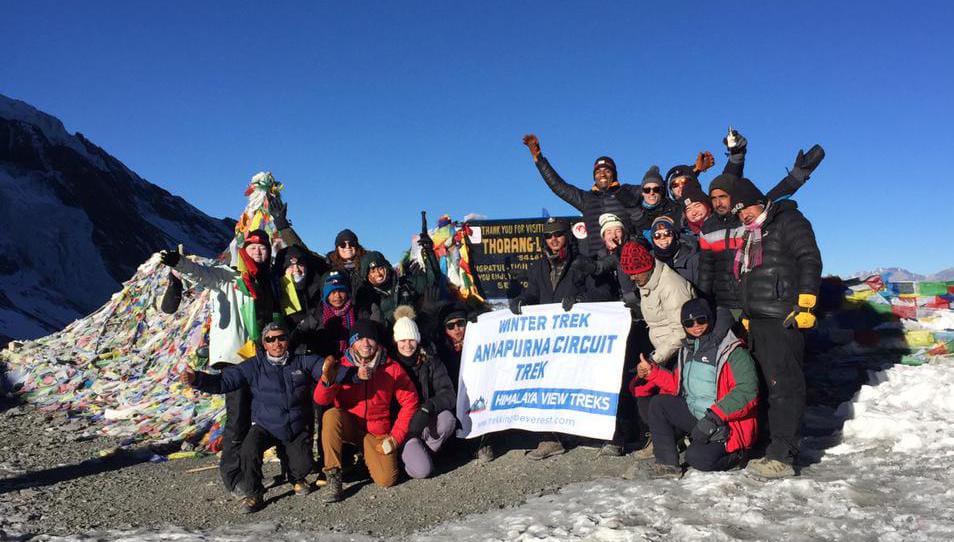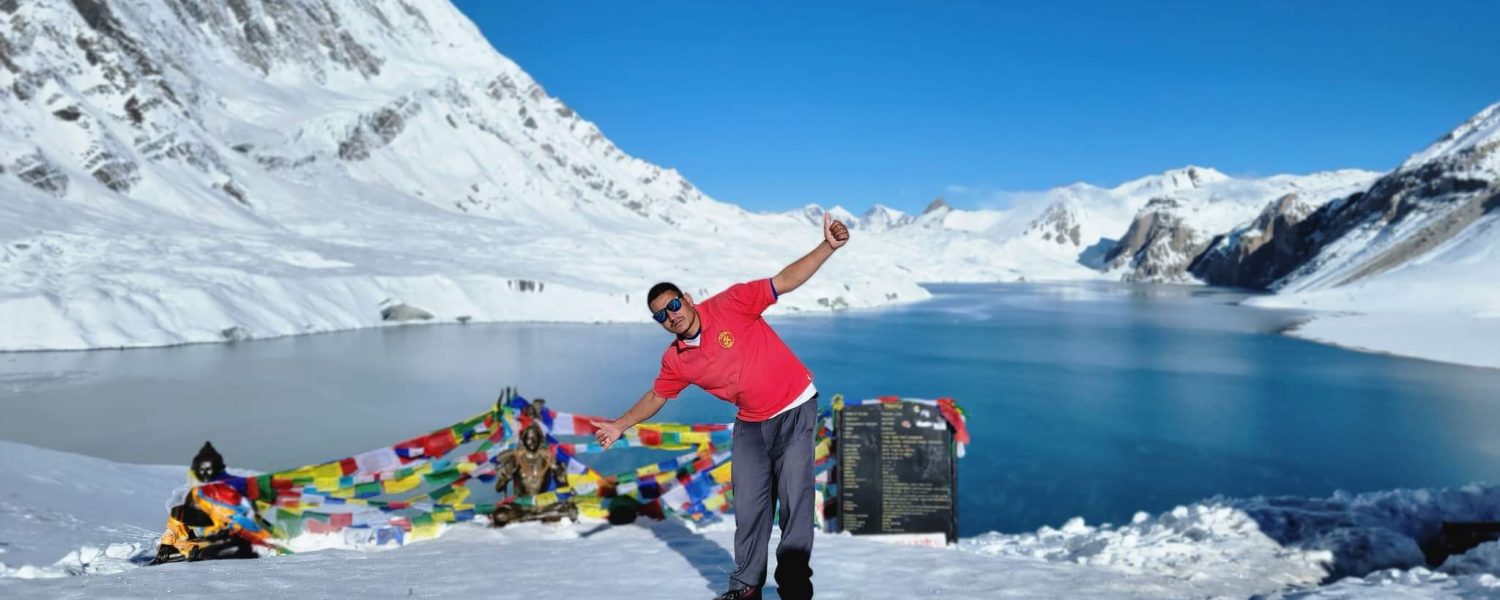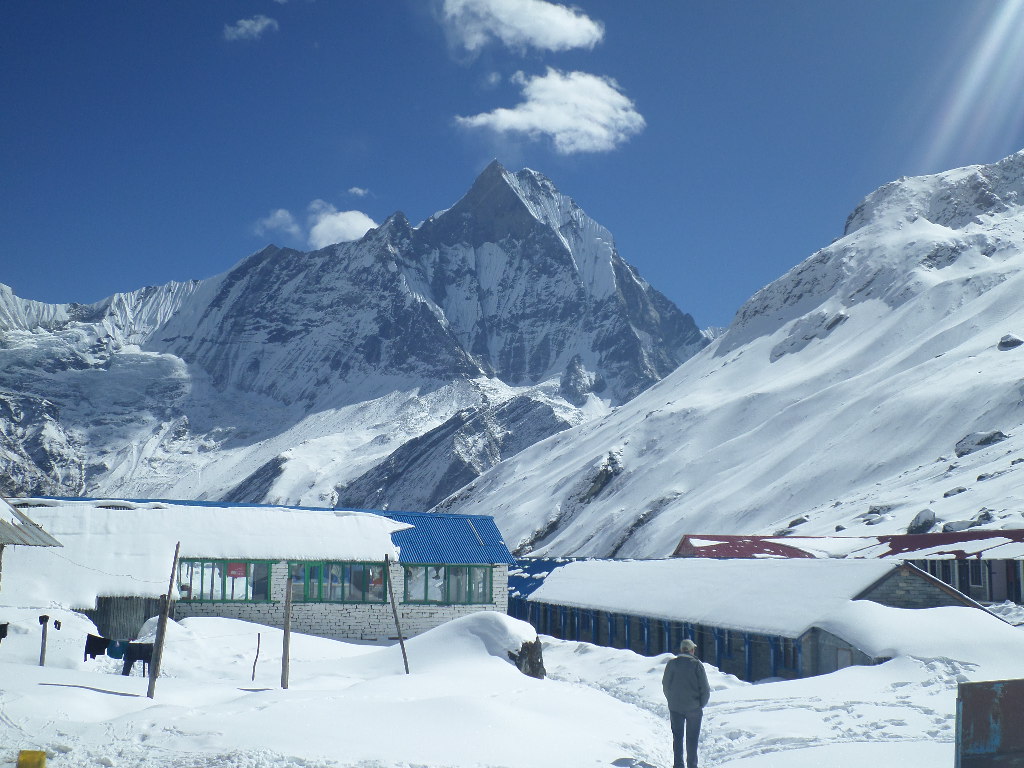Tilicho Lake and Thorong La Pass Difficulty: A Comprehensive Guide for Trekkers
Introduction
Two of the most breathtaking and difficult features of Nepal’s Annapurna Circuit are Tilicho Lake and Thorong La Pass. Tucked up in the heart of the Himalayas, these locations draw hikers from all over the world because they provide amazing scenery, a wealth of cultural experiences, and challenging trekking conditions. These paths offer a once-in-a-lifetime experience due to their unmatched beauty, but those who attempt them must possess a great deal of fortitude, readiness, and perseverance.
Tilicho Lake is one of the highest lakes in the world, standing at an incredible 4,919 meters (16,138 feet) above sea level. It takes a combination of rough paths, landslide-prone areas, and severe weather to get to this magnificent glacier lake. The captivating blue waters of Tilicho Lake, encircled by snow-capped peaks, produce an unearthly sight that few locations on Earth can match, making the effort worthwhile. Although it is a diversion from the conventional Annapurna Circuit, adventurers wishing to see the unspoiled splendour of the Himalayas are increasingly choosing to travel to Tilicho Lake.
At 5,416 meters (17,769 feet), Thorong La Pass is the highest point on the Annapurna Circuit and one of the world’s most dangerous high-altitude routes. With its steep ascents, bitter cold, and erratic weather, crossing this pass is regarded as the apex of the Annapurna journey. In order to avoid the strong afternoon winds that can make the crossing even more dangerous, the ascent to the pass starts early in the morning, frequently in below-freezing temperatures, from Thorong Phedi or High Camp. Trekkers are rewarded with an amazing 360-degree view of the Annapurna and Dhaulagiri mountain ranges upon reaching the peak, which makes every hardship seem worthwhile.
The trek is tough for the faint of heart, but the rewards of travelling these amazing paths are unmatched. Trekkers need to be ready for the physical challenges of multi-day trekking, severe weather, and high-altitude sickness. Due to the isolated location of these paths, it may be difficult to get assistance in an emergency, thus appropriate equipment, training, and acclimatisation are crucial.
This blog explores the degree of difficulty of Thorong La Pass and Tilicho Lake, offering comprehensive information on the altitude, geography, weather, and preparations required for a successful walk. Knowing what to expect will make sure you are prepared for an amazing trip across Nepal’s breathtaking Himalayas, regardless of your level of expertise trekking or your level of adventure.
Recognizing the Route and Terrain
The Annapurna Circuit, which includes Thorong La Pass and Tilicho Lake, is renowned for its varied terrain, which includes high-altitude deserts and rich subtropical woods. What to anticipate from each segment is as follows:
Trekking to the Tilicho Lake :
At 4,919 meters (16,138 feet) above sea level, Tilicho Lake is regarded as one of the world’s highest lakes. At Manang (3,519 meters), the Tilicho Lake trail splits off from the main Annapurna Circuit, taking hikers through a secluded and untamed area.

The Tilicho Lake Trek’s Difficulties and Features :
- Elevation Gain: It takes a lot of energy to climb the steep slope from Manang to Tilicho Base Camp (4,150 meters) and then to the lake itself. Acclimatisation is essential to preventing altitude sickness because of the quick altitude gain.
- Trail Conditions: The route is technically difficult due to its narrowness, loose rocks, and steep inclines. Extreme caution is needed in several areas, particularly those near landslide-prone areas.
- Weather Challenges: Tilicho Lake is cold all year round due to its high elevation, and the journey is made more difficult by strong winds. Snowfall and decreased visibility might result from abrupt weather changes.
- Accommodation and Facilities: Unlike the main Annapurna Circuit, the Tilicho Lake route has fewer tea houses and lodges, meaning trekkers need to be self-sufficient with food and supplies.
Many people consider the trip to Tilicho Lake to be a hidden treasure in the Annapurna region. Trekkers can completely immerse themselves in the unadulterated splendour of nature on this journey, which offers a secluded and tranquil experience in contrast to the busier portions of the Annapurna Circuit. Every difficult step is worth it because of the bizarre and even magical scenery created by the lake’s glistening blue waters and the tall, snow-capped peaks.
Additionally, the Tilicho hike offers a fantastic chance to see the region’s distinctive wildlife. In the more remote sections of the trail, hikers may see Himalayan blue sheep, marmots, and, if they’re lucky, even a snow leopard. The walk traverses breathtaking alpine meadows and rugged moraines, each offering unique rewards and challenges.
Trekkers must make sure they are emotionally and physically prepared for the challenges that lie ahead in order to finish the Tilicho Lake walk. The uncertain and frequently dangerous paths going to the lake require careful acclimatization, layered clothes, and durable trekking boots. Despite the challenges, arriving at this immaculate glacier lake offers an unmatched sense of accomplishment, making it one of the most fulfilling detours on the Annapurna Circuit.
Trekking to Thorong La Pass
At 5,416 meters (17,769 feet) above sea level, Thorong La Pass is the highest point on the Annapurna Circuit and one of the most strenuous parts of the journey. It is well known for its breathtaking vistas of the Himalayas, harsh weather, and steep ascent.

Challenges and Features of the Thorong La Pass Trek:
- Elevation Gain: The pass involves a grueling climb from Thorong Phedi (4,540 meters) or High Camp (4,880 meters) to the summit, covering a steep ascent that pushes trekkers to their limits.
- Trail Conditions: The path is rugged, steep, and exposed, often covered in loose rocks and patches of snow, making it difficult to traverse. The thin air at such a high altitude further complicates the climb.
- Weather Challenges: High winds, sub-zero temperatures, and the risk of sudden snowfall pose significant threats to trekkers. The coldest temperatures can drop well below freezing, making frostbite a potential concern.
- Acclimatization Needs: Proper acclimatization is crucial to avoiding altitude sickness, which can be dangerous at such an extreme elevation. Spending extra days in Manang or Ledar is highly recommended.
Trekkers usually begin their ascent in the early morning, often as early as 4 AM, to avoid the strongest winds that pick up later in the day. This timing is critical, as afternoon winds can make it almost impossible to traverse the pass. The climb is arduous, requiring slow, steady steps due to the thin oxygen levels. The ascent to the pass is demanding, but the descent toward Muktinath, though less physically taxing, is long and can be hard on the knees.
During winter months, the Thorong La Pass trek becomes even more treacherous due to heavy snowfall, making the path difficult to navigate and increasing the risk of avalanches. Many trekkers choose to avoid this route during peak winter due to its extreme conditions.
Despite these hardships, reaching the summit of Thorong La Pass is a moment of pure triumph. Trekkers are rewarded with a breathtaking panoramic view of the surrounding Himalayan peaks, including Annapurna, Dhaulagiri, and Nilgiri. The sense of accomplishment upon conquering one of the highest trekking passes in the world is unparalleled, making all the challenges worthwhile.
Difficulty Factors in Trekking to Tilicho Lake and Crossing Thorong La Pass
The trek to Tilicho Lake and crossing the Thorong La Pass is considered one of the most challenging high-altitude treks in the world. The difficulty of this trek is influenced by several key factors such as altitude, physical fitness, weather conditions, and logistical challenges. Below is an expanded look at these factors:
-
Altitude and Acclimatization
Altitude plays a critical role in the difficulty of this trek. As trekkers ascend higher into the Himalayas, the oxygen levels in the air decrease. Above 3,000 meters (9,843 feet), the risk of altitude sickness becomes prominent, and it continues to increase with each higher elevation.
Symptoms of altitude sickness can range from mild (headaches, dizziness, nausea) to severe (vomiting, confusion, inability to walk). Severe altitude sickness can be life-threatening and requires immediate descent.
To combat this risk, acclimatization is essential. Acclimatization is the process of allowing your body to adjust gradually to higher altitudes. In the context of this trek, it is crucial to:
- Take extra rest days at strategic points such as Manang or Tilicho Base Camp.
- Follow the golden rule of altitude trekking: “Climb high, sleep low.” This means ascending to a higher elevation during the day but returning to a lower elevation to sleep.
By incorporating rest days, the body can gradually adjust, helping to reduce the chances of altitude sickness. The trek is typically planned so that you don’t ascend more than 500 meters (1,640 feet) per day above 3,000 meters, which is a key guideline for effective acclimatization.
-
Physical Endurance and Fitness Requirements
The trek to Tilicho Lake and Thorong La Pass requires a high level of physical endurance. Trekkers are expected to hike long hours each day, typically between 6-10 hours per day, which can be very taxing at high altitudes. The combination of steep ascents and descents, rough rocky trails, and carrying personal gear adds to the difficulty.
Key aspects of the trek include:
- Steep ascents and descents: The trail can be exhausting as it winds through rugged terrain. The steep inclines can make the hike feel more intense, especially when combined with the reduced oxygen levels at high altitudes.
- Rough, unstable trails: The terrain is often rocky and uneven, increasing the likelihood of slips or falls. Some stretches are more remote, requiring more effort to navigate safely.
- Carrying personal gear and essentials: Trekkers will need to carry their own backpacks, including personal gear, food, water, and sometimes sleeping equipment. This can be taxing, especially over several days of strenuous hiking.
For preparation, trekkers should engage in regular cardiovascular workouts (such as running, swimming, or cycling) and strength training focused on the legs, core, and shoulders. It is also recommended to practice long-distance hikes with a weighted backpack to simulate the trek’s demands.
-
Weather Conditions and Challenges
The weather in the Himalayas is notorious for being unpredictable and harsh, making it a significant challenge for trekkers. The region experiences four distinct seasons, each with its own set of challenges:
- Winter (December to February): The coldest time of the year, with extremely low temperatures and heavy snowfall. The trail conditions can become treacherous, with snow and ice making the journey hazardous.
- Spring (March to May): The ideal time for trekking, as temperatures are moderate, skies are generally clear, and the wild rhododendrons are in bloom. This is considered one of the best seasons for trekking to Tilicho Lake and Thorong La Pass.
- Monsoon (June to August): Heavy rains lead to increased risk of landslides, flooding, and slippery trails. Many sections of the trek become difficult to navigate, making this season unsuitable for trekking.
- Autumn (September to November): Another peak season for trekking due to the clear skies and stable weather. The weather is mild, making it perfect for long days on the trail.
Winter trekking, while possible, carries the added risk of freezing temperatures, especially at high altitudes like Thorong La Pass, where temperatures can drop below -20°C (-4°F). These conditions can create severe risks, including frostbite and hypothermia.
-
Logistical Challenges and Remote Terrain
Both Tilicho Lake and Thorong La Pass are located in remote parts of the Annapurna region. The trek requires trekkers to venture through isolated villages and regions with minimal facilities. Some logistical challenges include:
- Longer trek duration: The side trip to Tilicho Lake adds additional days to the overall trek, making the journey longer and more demanding.
- Limited facilities: In the more remote sections of the trek, there are limited accommodations, food options, and medical facilities. Trekkers must be prepared to carry enough food, water, and other essentials to last for several days.
- Communication issues: Limited cell phone service and no reliable internet make communication with the outside world challenging. In case of emergencies, this can pose additional risks.
Essential Preparations for the Difficulty Trek in Nepal
- Physical Training and Conditioning To ensure that you are physically prepared for the challenges of this trek, you should focus on:
- Cardiovascular exercises (running, cycling, swimming, hiking) to build endurance.
- Strength training, particularly for the legs, core, and shoulders, as these muscle groups are essential for managing steep ascents and carrying a loaded pack.
- Endurance hikes with a weighted backpack to simulate the trek’s conditions.
- Packing the Right Gear Packing the right gear is critical to handle the difficult conditions. Essential items include:
- Sturdy trekking boots with ankle support to handle rocky terrain.
- Sleeping bag rated for cold temperatures, as it can get very cold, especially at night.
- Layered clothing to adjust to varying temperatures. This should include moisture-wicking base layers, insulating mid-layers, and a waterproof outer layer.
- Trekking poles to help with stability, especially when descending or navigating rough paths.
- Sunglasses, gloves, and a warm hat to protect against the sun and cold.
- Hydration system (water bottle or hydration pack) along with purification tablets to ensure access to clean drinking water.
- Energy snacks such as nuts, chocolate, and trail mix to maintain energy levels.
- Emergency medical supplies like a first aid kit, pain relievers, altitude sickness medications, and blister treatment.
- Hiring Guides and Porters Although the trek can be completed independently, hiring a guide and porter can be beneficial for a safer and more enjoyable experience:
- A guide will not only help navigate the trail but also provide insight into the local culture and assist in case of emergencies.
- A porter can help reduce the physical burden of carrying heavy gear, allowing trekkers to focus on the trail itself.
Hiring local guides and porters also supports the local economy and fosters sustainable tourism in the region.
By thoroughly preparing for the physical, logistical, and environmental challenges, trekkers can have a safe and memorable adventure on one of the most iconic high-altitude treks in the world.
Conclusion
The experience of trekking to Tilicho Lake and across Thorong La Pass necessitates fortitude, readiness, and consideration for the difficulties presented by nature. The rewards—unspoiled alpine landscapes, cultural interactions, and personal accomplishment—make the trek one of the most remarkable trekking experiences in the Himalayas, despite the physical and mental strain. A successful and rewarding journey across these famous Himalayan sites will be ensured by careful preparation, training, and understanding of the challenges involved.
FAQs:
- How difficult is the trek to Tilicho Lake and Thorong La Pass?
The trek is considered challenging due to high altitudes, steep ascents, unpredictable weather, and rough terrain. Proper acclimatization, physical fitness, and preparation are essential to successfully completing the trek.
- When is the ideal time to hike to Thorong La Pass and Tilicho Lake?
When the weather is consistent, visibility is clear, and temperatures are mild, spring (March–May) and fall (September–November) are the ideal seasons. The monsoon season (June to August) brings landslides and a lot of rain, while the winter months (December to February) are bitterly cold. - How likely is altitude sickness to occur on this trek?
A major worry is altitude sickness, particularly above 3,000 meters (9,843 feet). Headaches, lightheadedness, nausea, and exhaustion are among the symptoms.
- Can beginners attempt this trek?
While beginners can attempt the trek, it is highly demanding and requires prior trekking experience, good physical fitness, and proper preparation. First-time trekkers should consider hiring a guide and porter for assistance.
- What sort of lodging is offered?
There are simple tea shops and lodges along the way, but the amenities get worse close to Thorong Phedi and Tilicho Base Camp. Because nighttime temperatures might drop considerably, it is suggested to bring a sleeping bag.





